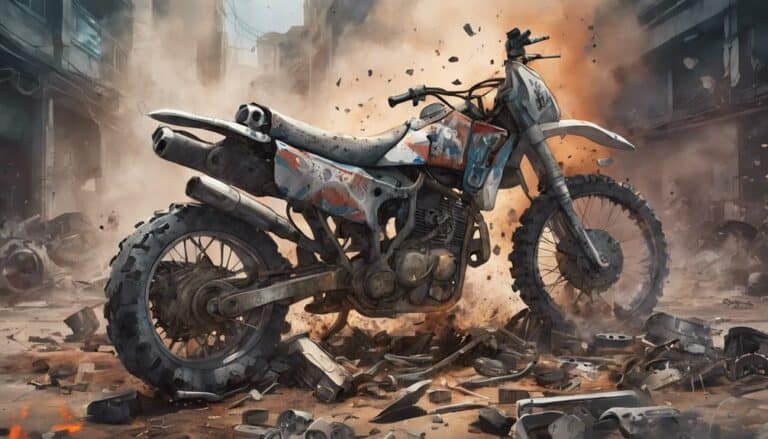You're out on the trails, feeling the wind in your face, when suddenly, your dirt bike emits a loud bang and stops dead in its tracks. Ever wondered why dirt bikes blow up?
The answer lies in a combination of factors that can lead to catastrophic engine failure. From improper maintenance practices to the stresses of high-speed riding, understanding the causes can help you prevent such a nightmare scenario.
So, what are the key culprits behind these fiery explosions?
Key Takeaways
- Lack of regular maintenance and neglecting oil changes can lead to dirt bike engine failure.
- Overheating due to coolant leaks and inadequate monitoring can cause dirt bike explosions.
- Incorrect fuel mixture and dirty jets can contribute to engine failures and potential detonation.
- Aggressive riding styles and exceeding the bike's capabilities can result in significant engine damage.
Common Causes of Dirt Bike Engine Failure
Common reasons for dirt bike engine failure include:
- Oil starvation leading to critical parts seizing
- Excessive high RPM operation causing accelerated wear
- Valve failures due to irregular clearances
- Intake tract debris
- Insufficient lubrication
When it comes to engine failure, the cam chain is a critical component that can be affected. High RPMs can put excessive strain on the cam chain, leading to wear and potential failure. Regular maintenance, including checking and adjusting cam chain tension, is essential to prevent issues with this component.
Another essential aspect to contemplate is the air filter. A clogged or dirty air filter can restrict airflow to the engine, causing it to run lean and potentially overheat. This can lead to engine failure if not addressed promptly. Regularly inspecting and cleaning or replacing the air filter is indispensable for maintaining prime engine performance and preventing catastrophic damage.
Paying attention to these details can make a significant difference in the longevity and reliability of your dirt bike engine, ultimately avoiding costly repairs and downtime.
The Role of Maintenance in Preventing Explosions
Regularly maintaining your dirt bike through scheduled oil changes and air filter inspections is important in preventing catastrophic explosions caused by cam seizing and piston damage. The oil pump plays a vital role in lubricating the engine components, including the piston, to guarantee smooth operation.
Ignoring regular oil changes can lead to increased friction between the piston and cylinder walls, potentially resulting in catastrophic failures. For two-stroke bikes, adhering to the recommended piston change intervals, typically every 10 gallons of gas, is essential to prevent oil-related failures like cam seizing and piston damage.
Additionally, dusty riding conditions demand more frequent air filter checks and replacements to avoid debris from infiltrating the engine and causing damage. Overextending maintenance intervals, such as delaying piston changes beyond the recommended 10-gallon mark, can result in costly repairs and increase the risk of dirt bike explosions.
Understanding Overheating and Its Consequences
To prevent catastrophic overheating and its damaging consequences in dirt bikes, vigilance in monitoring coolant levels and addressing potential leaks is paramount. Overheating can lead to severe issues such as warping of cylinder heads and blowing of head gaskets. Leaking water pump seals are common culprits contributing to overheating problems in dirt bike engines.
When engines operate at high RPMs, coolant leaks may occur, ultimately causing overheating and potential damage. Neglecting coolant levels, particularly in hot weather conditions, can result in engine overheating. It's essential to conduct regular checks on coolant levels and conduct proper maintenance to prevent overheating and potential engine failure.
Ignoring signs of overheating can lead to costly repairs, such as timing chain adjustments, extensive engine work, or even the need for a new piston. Take proactive measures to avoid overheating issues and preserve the longevity of your dirt bike's engine.
Fuel and Ignition System Issues Explained
When diagnosing issues with dirt bike engines, understanding the intricacies of fuel and ignition system problems is essential for peak performance and durability. Incorrect fuel mixture or dirty jets can lead to lean conditions, causing detonation and potential piston damage.
Engine failure can occur due to inadequate fuel combustion resulting from incorrect jetting or using poor-quality pump gas. Dirty fuel can clog jets, affecting the air-fuel ratio and potentially causing engine damage like piston scoring. To improve fuel quality and prevent detonation, using additives or higher octane race gas is recommended.
Fuel management plays a critical role in preventing engine failure, and selecting the right fuel type based on atmospheric conditions can have a significant impact on engine reliability. By ensuring a proper fuel mixture, keeping jets clean, and choosing the right octane level, you can enhance your dirt bike's performance and longevity.
How Riding Style Influences Engine Health
Your riding style directly impacts the health and longevity of your dirt bike's engine. To guarantee your engine's well-being, consider the following:
- Aggressive Riding Styles: Constant over-revving and hard landings strain engine components, potentially leading to premature wear and engine failure.
- Jumping Beyond Bike's Capabilities: Excessive jumps, especially beyond the bike's capabilities, can cause timing chain issues, particularly notable in models like KTMs, increasing the risk of engine damage.
- Overextending Engine Limits: Continuous high RPMs can push the engine beyond its limits, resulting in coolant leaks, overheating, and catastrophic failures due to excessive stress.
- Neglecting Proper Maintenance: Failure to maintain coolant levels and other routine checks can lead to overheating, warped heads, blown gaskets, and other significant engine damage over time.
Maintaining a balanced riding style within your bike's capabilities, combined with regular maintenance and care, is pivotal to prevent engine abuse, overheating, and potential dirt bike engine blow-ups.
Conclusion
You've learned the ins and outs of why dirt bikes blow up and how proper maintenance can prevent catastrophic engine failures.
Just like a skilled mechanic fine-tuning a precision instrument, taking care of your dirt bike guarantees it runs smoothly and reliably.
So, remember to keep those engines purring like a well-oiled machine to avoid any fiery surprises on your next ride.
Happy trails and safe travels!

